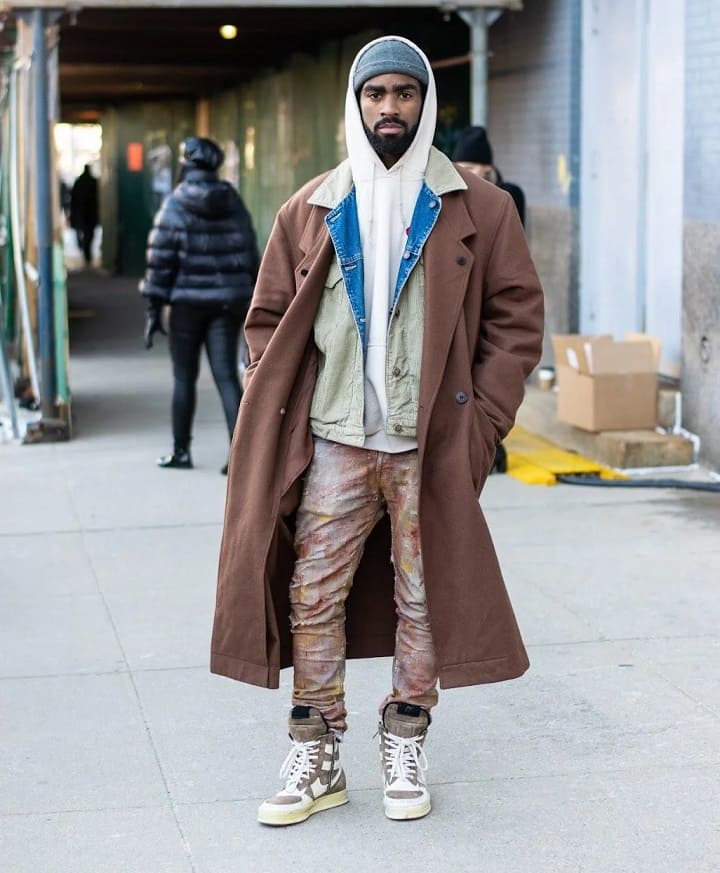Looking to elevate your streetwear style? Layering is a great way to add depth and complexity to your outfit, while keeping you comfortable in changing temperatures. Here are a few tips for mastering the art of layering men’s streetwear.
- Start thin and work your way up. The key to a successful layering look is to balance different textures and weights. Start with a lightweight base layer, like a cotton t-shirt or a button-down shirt, and build up from there. For example, you could add a lightweight sweater or a denim jacket, and then top it off with a heavier coat or a parka.
- Stick to three layers. While it can be tempting to pile on more and more layers, three is usually the sweet spot for a balanced, streamlined look. Any more than that and you risk looking bulky and overdone. Plus, too many layers can make it hard to move around comfortably.
- Play with color and contrast. Layering is a great opportunity to experiment with color and texture. One classic rule of thumb is to wear lighter colors closer to your body, and darker colors farther out. This creates a sense of depth and dimension. However, don’t be afraid to mix and match different hues and shades. For example, you could pair a dark jacket with a bright sweater or a patterned shirt.
- Make sure each layer works on its own. The key to a successful layering look is to make sure each piece looks great on its own, as well as in combination with the other layers. This means paying attention to fit, color, and overall style. Don’t just throw on any old shirt or jacket – make sure it complements the other pieces in your outfit.
By following these simple guidelines, you can create stylish and functional layered looks that are perfect for any occasion. So go ahead and experiment with different combinations of clothes and textures, and see what works best for you.
How to dress men in layers?
5 Best Tips to Style Streetwear Fashion (In 2023)
- Colorful Coats: ‘The Matrix’ has returned to the big screen, therefore it’s time to revisit some of the best aesthetics from the original film.
- Oversized Hoodies
- Loose Styles
- Blend Sportswear
- Silent Logos – No Branded Outfits.
What kind of people wear streetwear?
The fashion industry defines streetwear as fashionable, casual clothing worn by followers of popular culture. The majority of these followers are under 30, live in urban areas, and belong to a subculture group (ex. skateboarders or hip-hop music fans).

That’s why we’ve rounded up 8 must-have types of streetwear clothing that are always on-trend.
- Sneakers. @virgilabloh.
- Logo Tees.
- Hoodies.
- Sweatpants.
- Denim Jackets.
- Puffer Jackets.
- Ribbed Socks.
- Slide Sandals.
Is streetwear supposed to be baggy?
Stay away from relaxed-fit shapeless (boxy) pieces, as they tend to make you look larger and unflattering, which isn’t the point of the baggy clothing aesthetic. Keep it casual. The baggy clothes aesthetic is perfect for streetwear fashion, grunge and indie rocker styles, and urban/hip-hop fashion aesthetics.
Who is the target audience for streetwear?
Our research shows that consumers of cosmetic clothing on the streets are mainly young people under the age of 25. The target market for streetwear aesthetics is also not the wealthiest group. These are people who make less than $40,000 a year. But that doesn’t mean they don’t have money to spend on top brands.
What kind of style is streetwear?
Streetwear is a style of casual clothing which became global in the 1990s. It grew from New York hip hop fashion and Californian surf culture to encompass elements of sportswear, punk, skateboarding and Japanese street fashion. Eventually haute couture became an influence.
Can adults wear streetwear?
“There isn’t an age cut-off for streetwear,” says stylist and photographer Chris Tang. “But an older guy should stick to what they like and what works for them.” The grown-up move is to fly below-the-radar, by wearing streetwear labels that are innovative but don’t have teenagers queued up outside their store.
What is the purpose of streetwear?
In essence, streetwear involves the production, promotion, sale and resale of casual fashion, principally of footwear, such as sneakers, but also T-shirts and other items – in ways that bypass traditional retail channels, often subverting the way the fashion industry has long defined and dictated how “cool” is made
Who is the streetwear consumer?
But, according to surveys conducted by Strategy& and HYPEBEAST, streetwear buyers are young and “not all that wealthy.” In fact, the research highlighted that over 60 percent of respondents were under 25, and about 70 percent reported having an annual income of $40,000 or less: not your traditional luxury demographic.
What is the target market for clothing brand?
Customer Segmentation
High school and middle school age consumers looking for the trendiest in latest fashion. College age consumers that are looking for trendy clothing at an affordable price. Young professionals in search of trendy clothing at an affordable price for themselves and their children.
What is the demand for streetwear?
Streetwear Market with 1.82% CAGR : Size In 2022, Industry Analysis By Demand, Top Players, Opportunities, and Growth Rate Through 2027 | 126 Report Pages. The size of the global Streetwear market was estimated to be USD 173399.5 in 2021 and to increase to USD 193217.4 by 2028, with a forecasted CAGR of 1.82%.
How big is streetwear market?
The global Streetwear market size was valued at USD 173399.5 million in 2021 and is expected to expand at a CAGR of 1.82% during the forecast period, reaching USD 193217.4 million by 2027.
What is the streetwear industry?
Streetwear is a style of casual clothing which became global in the 1990s. It grew from New York hip hop fashion and Californian surf culture to encompass elements of sportswear, punk, skateboarding and Japanese street fashion. Eventually haute couture became an influence.